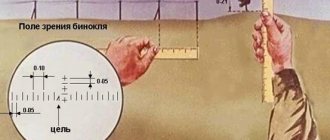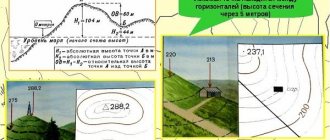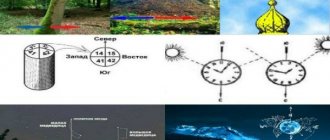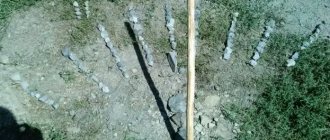Basic knowledge
For night navigation you need a little: the presence of the satellite itself (sometimes the sky is densely overcast), the ability to count to 12, or at least to 6, and knowledge of a couple of letters. But seriously: you need to know exactly what phase the Moon is in in order to determine the cardinal directions. The Latin word “oriens” lies at the root of the concept of “orientation” and means “east”, that is, you need to figure out where the desired direction is located.
A simple method has long been invented to find out whether a star is growing or aging: imagine that the edges of a sickle are connected with a conventional stick. Those who know the alphabet will see either the letter “C” or “P” and associate the words “s - old”, “p - growing”.
Definition of waning and waxing moon
Age is assessed as follows:
- Compare its appearance with a picture that shows the position of the terminator (the line dividing the light and dark parts with an interval of 1 day). After the full moon, they use the same pattern, but upside down.
- It is clear that no traveler will carry an image with them. But everyone can divide the transverse central line into 12 (or 6) parts.
The number of these “slices” is useful when determining the direction of the world
There are several methods for orienting on the Moon:
- without using any instruments, apply knowledge about the location of the luminary depending on the phase and time of day;
- according to the moon and hours;
- by the moon and stars.
Note! These methods are not considered perfect, but they will help indicate the main direction.
Determining cardinal directions by the Moon
The full moon at midnight is always in the south.
Expert opinion
Makarov Igor Tarasovich
Hunter and fisherman with 20 years of experience. Wildlife lover
The degree of illumination of the Moon depends on the position of the Sun. For example, if the Moon is full, then it is behind you, if the Moon is in the first quarter, then it is on the right, etc.
Even if the fullness of the Moon cannot be expressed in one word, then the azimuth of the Sun can also be calculated. And using it you can already find the south.
To find out the direction to the Sun from the not fully illuminated Moon, you need to mentally divide the lunar disk into six parts and estimate how many sixths are illuminated. The same difference in hours will be between the directions to these two luminaries. Example in the picture.
And here is the army method of determining the cardinal directions by the moon. Here you do not need to know where the Sun is at the moment, but the disk of the Moon will have to be divided not into six, but into twelve parts.
How many twelfths of the Moon are illuminated, so many hours forward/backward you need to set your watch. And then, using the new time and taking the Moon for the Sun, find the south, as described at the beginning of the article.
Methods for orienting on the Moon without instruments
If a traveler does not currently have a compass or a phone with a GPS function, remember the school astronomy course. It is known that the earth's satellite appears in the sky at a certain time in a certain place.
So, there are four main phases:
- new moon;
- first quarter;
- full moon;
- last quarter.
Moon phases
Regarding the time of day, the side of the horizon by month is determined from the table:
| Time/Phase | 7 pm | 01 nights | 7 am |
| New moon | Not visible | ||
| First quarter | South | West | |
| Young growing month | Southwest | West | |
| Full moon | East | South | West |
| Old waning | East | South | |
| Last quarter | East | South | |
This method of lunar orientation is also used in areas of magnetic anomalies.
Determining the sides of the horizon by the Moon and the clock
It is easier to determine the sides of the horizon using a satellite if you have a mechanical watch. The Full Moon is a reflection of the Sun. Compared to this, the difference is 12 hours. If there is a full moon, the cardinal directions are determined in the same way as by the Sun, namely:
- at 7 am the Sun is in the east; Earth's satellite in the west;
- at noon, at 13 o'clock, the Sun is on the south side, the Moon is on the north side;
- at 19 o'clock the Sun is in the west, the Moon is in the east.
Let's look at an example. Full moon, 2 am. They stand facing the luminary. Place the watch horizontally on your palm. The hour hand is directed to the month. An angle has formed between the hour hand and the number 1 - divide it in half. The imaginary dividing line points south.
Determining cardinal directions on a full moon
The intermediate phases of the satellite will take a little longer. When the disk grows, time is noted, how many of the 6 parts are visible across the diameter of the sickle, and the resulting number is subtracted from the hour of observation.
For example, 3/6 of the disk is visible, the clock shows 2 am. Count down 3 hours ago, it turns out 11. Become the number 11 in the direction of the Moon. The resulting angle between 11 and 1 is divided in half.
Determining cardinal directions when the moon is waxing
Angle values
The phases of the Moon are determined by its angular position relative to the Earth-Sun axis.
The most important thing in calculations is to correctly determine noon. The angles indicating the direction north or south will depend on the accuracy of this value. The hour hand and the imaginary line of true noon form an angle, dividing it in half to obtain the direction. The value of the angles between the segments on the clock is directly proportional to the position relative to the Sun. The error in degrees is the distance in degrees of longitude to the meridian where the traveler is located.
When defining noon, we talk about 12 noon. But if the country has introduced summer time, then in winter it is 13 hours. In the daytime, true noon is calculated by observing the shadow from 11 a.m. to 2 p.m. The shortest shadow will indicate the exact time that you will need to navigate at night.
Method errors
The deviation in orientation calculations by month can be 10⁰-15⁰. Experienced pathfinders and travelers advise taking repeated measurements every half hour and, if necessary, adjusting the direction so that navigation at night is effective.
The further north the area, the more accurate the result. In summer in the southern regions the error can be equal to ¼ (25%). Autumn and spring guarantee almost exact determination.
Purslane ( Portulaca
)
Purslane, or dandur, is a genus of annual and perennial herbaceous plants of the purslanaceae family.
Division: Angiosperms Class: Dicotyledons Order: Dicotyledons Family: Purslanaceae Genus: Purslane Purslane got its name from the Latin word ' portula'
' - collar, which is associated with the nature of the opening of its seed pod.
This is a low-growing, creeping ornamental plant native to the tropical and subtropical zones of America. According to some estimates, there are up to 100 species of purslane in nature. Purslane is a ground cover plant 10–15 cm high with small and narrow leaves. The flowers are usually bright - red, yellow, orange, pink, purple and white; On some flowers you can find a border, stripes or eyes. Purslane flowers can be either simple or double or semi-double. This bright herbaceous plant is ideally suited for planting in a rock garden or rock garden; it grows well on rocky hills and supporting walls. Purslane grows well along paths paved with stones or covered with gravel: the stones reflect the sunlight that this plant loves so much. You can plant purslane in a tub, a hanging basket, or a box on the balcony - it will fit anywhere, as long as there is enough light. It's no secret that purslane can be a substitute for a regular grass lawn if the soil is dry and poor and the place is sunny. Purslane's love for sunlight largely determines its neighbors - it goes well with sun-loving plants like itself. If you have a flowerbed where Gatsania, Gomphrena globulus or Californian Eschscholzia grows, you can use purslane to frame it. Some types of purslane:
grandiflora purslane (
Portulaca grandiflora
), umbrella purslane (
Portulaca umbraticola
), garden purslane (
Portulaca oleracea
).
The most common purslane grandiflora is a perennial grown as an annual, with creeping, pubescent light green stems and fleshy, cylindrical leaves arranged alternately. The flowers reach a diameter of 6 cm. Place.
Purslane is a very heat-loving plant; grow it in an area with bright sun, as it does not tolerate even partial shade.
The soil.
It is better to grow purslane on sandy, permeable, infertile soil;
it grows poorly in rich soils. If the soil turns out to be heavy and clayey, then the purslane is very likely to rot its roots. Disembarkation.
Purslane can be propagated by seeds and cuttings.
For seed propagation, sowing can begin approximately in mid-March. Seeds (3–5 pieces each) are sown in boxes filled with clean soil for seedlings. Remember that seeds need light to germinate, so do not cover them with opaque materials, but use film or glass for this and keep the boxes in a bright place. When sprouts appear, the film must be removed. When the sprouts reach a height of about 2.5 cm, the seedlings are thinned out, leaving two sprouts in each pot. In early June, seedlings can be planted in the ground at a distance of 15–20 cm from each other. When propagating from cuttings, take pots for seedlings and fill them with a mixture of peat and sand. Remove the lower leaves from purslane cuttings about 5 cm long and plant them in prepared soil. Flowering period.
Purslane blooms from June to October.
Care.
Purslane does not need a lot of moisture and can easily tolerate dry periods, but if you regularly water it in extreme heat, it blooms much better.
Purslane needs to be fed with liquid fertilizers, feeding once a month and starting immediately after the flowers form. If you want the purslane to bloom earlier in the spring, then in the fall, before the first frost, select some of the plants and replant them in pots, which you store indoors until spring. Diseases and pests.
Purslane can be affected by small insect pests, thrips, which suck the juice from the plant, and the leaves become covered with silvery specks.
Source:
gardenmix.ru - a directory of garden flowers.
Additional information on the websites:
- moisad.ua - purslane;
- lepestok.kharkov.ua - why I love purslane;
- plantopedia.ru - purslane, brief information about the plant;
- floweryvale.ru - garden purslane: cultivation and beneficial properties;
- marichka.kiev.ua - purslane in your garden plot (planting purslane, beneficial properties of purslane);
- botanichka.ru - a friend among weeds, a stranger among vegetables;
- ukrspice.kiev.ua - purslane, characteristics and origin.
Orientation by the Moon and stars
The reliability of the method is high, the error is low. Looking for direction by the stars is a justified way if the sky is clear, not overcast, or if the moon appears at least occasionally.
- Everyone will recognize the Big Dipper's Bucket. Look closely at the outermost star of the bucket and connect it to the star on the other side. This distance is conventionally designated “1 step”, and, continuing the imaginary line, they take another 5 steps.
- There, at the head of the handle of the small bucket, is the North Star. Its bright glow always points in the northern direction.
Ursa Major Dipper
Important! In the crescent phase of the Moon, they are guided by “horns” that are connected by an imaginary line. The lower part of the line points to the south, the upper part to the north.
Waning moon
For orientation relative to the cardinal points during the waning Moon, the following method is used:
For example, the clock shows 4 am:
- Mentally dividing the diagonal by 6, they look at what part the light part occupies. For example, 2 out of 6.
- Determine whether he is growing or aging (P, C). For further calculations, another mnemonic technique is used: P – “difference”, C – “sum”.
- They look at the clock and note the time.
To 4 (time on the clock) add 2 (lightened parts). It turns out 6. This means that at 6 o’clock the Sun will be in this place:
- take the watch, place it horizontally in the palm of your hand, turn it so that the number 6 is directed towards the Moon;
- the angle formed by the intersection of lines 1 and 6 is divided in half to obtain the southern direction.
Determining direction based on the waning moon
A traveler's best friend is mindfulness. On the road, you need to notice the surrounding objects and “photograph” the area. But if you do happen to lose your way, the main thing is not to panic. You can take a break, wait for the morning, raise your head and look at the stars. They are always ready to help.
Were you able to obtain new information? Share in the comments!
Which side of the world is the moon on? Determining cardinal directions by moonrise and moonset during a full moon
The exact time of moonrise and moonset is a terrain-dependent parameter, and this dependence is determined not only by the tilt of the earth’s axis, but also by the proximity of the moon itself to us...
Content:
Moon today
The time of rising and setting of the Moon, as well as the Sun, depends on the location of the observer on the Earth’s surface, that is, in calculations it is determined by the latitude and longitude of the observation point. To calculate exactly when the Moon will rise today, for example, in Moscow, you need to indicate the coordinates of the city. Let's see how the Moon behaves today, and from the points of view of two observers - from Moscow and St. Petersburg. For clarity, the calculations are supplemented with an illustration of the state of the Moon, with background colors symbolizing the signs of the zodiac:
Calculation of the exact time of rising and setting of the Moon and Sun today in Moscow and St. Petersburg (online)
Moscow ( 55.83 37.62 ) Saturday, 02 January 2021 (Fri, 01 Jan 2021 21:05:01 GMT)
Today is 20
lunar day
Moon in Moscow
Moonset:
11:21
Moonrise:
19:44
Sun in Moscow
Sunrise:
09:00
Sunset:
16:09
Solar noon:
12:34
St. Petersburg (59.57 30.19) Saturday, 02 January 2021 (Fri, 01 Jan 2021 21:05:01 GMT)
Today is coming 20
lunar day
Moon in St. Petersburg
Moonset:
12:14
Moonrise:
19:52 Sun in St. Petersburg
Sunrise:
10:00
Sunset:
16:06
Solar noon:
13:03
Calculation of the time of rising and setting of the Moon and the Sun in a city or locality selected on the map in Russia and the world
Nizhny Novgorod, Russia
56.326887 C, 44.005986 V
Saturday, 02 January 2021 (Fri, 01 Jan 2021 21:05:01 GMT)
Today is coming 20
lunar day Moonset:
10:57
Moonrise:
19:15
Sunrise:
08:38
Sunset:
15:40
Solar noon:
12:08
Enter the name of your city, town or simply the coordinates of the area in the field that opens after clicking the “Find” button on the map on the left.
The calculation is based on the time settings in your device.
— Widget for calculating the time of rising and setting of the Moon and Sun at a selected point on the map
Moon phase does not depend on location
It is now 00:00, 02 January 2021 Saturday
Moon phase: Waning moon in 3rd quarter
International name of the phase: Waning gibbous
Russian folk title for the phase: Defective Moon (the Moon is at a loss, the pot-bellied month is on the wane)
Moon illumination: 92%
Moon age: 18 days 4 hours 43 minutes
Distance to the Moon: 382383 km, middle Moon
Zodiac sign: Moon in the sign Leo , λ: 134°14' Constellation: Moon visible in the constellation Cancer
Expected new moon: January 13, 2021 07:59 Nearest full moon: January 28, 2021 22:16
Update Clock Mini Widget Time Machine Stop
Lunar phase calendar for the entire year 2021 on the page Moon phases and eclipses 2020











